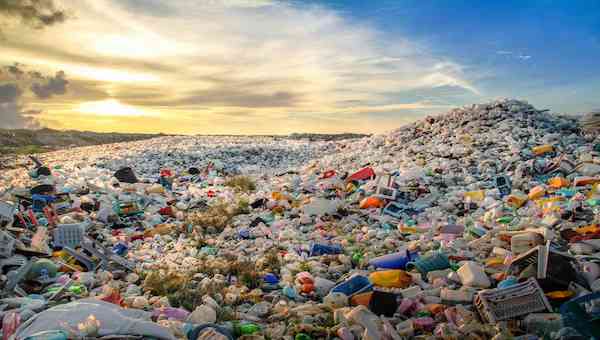 Abdul Raheem Mohamed / EyeEm / Getty Images
Abdul Raheem Mohamed / EyeEm / Getty Images
SCIENTISTS DISCOVER SURPRISING REMEDY TO PLASTIC POLLUTION: CATERPILLAR SPIT
BY: MATT ALDERTON - FACT CHECKER: HALEY MASTSITE: TREEHUGGER
TRENDING
Activism
AI
Belief
Big Pharma
Conspiracy
Cult
Culture
Economy
Education
Entertainment
Environment
Faith
Global
Government
Health
Hi Tech
Leadership
Politics
Prophecy
Science
Security
Social Climate
Universe
War
The saliva of wax worms contains enzymes that can break down plastic in a matter of hours, new research shows.
Because they eventually become moths or butterflies, all caterpillars are destined for greatness. The larvae of at least one species, however, are equipped to do great things even before their metamorphosis, finds a new study published this month in the journal Nature Communications.
The species— Galleria mellonella , otherwise known as the wax worm—may be able to help humanity manage its plastic waste problem, according to researchers. The scientists found wax worms can naturally degrade plastic with the help of their saliva, which contains special enzymes that quickly oxidize and depolymerize the polyethylene that’s used in plastic packaging, bags, bottles, and more. That’s important because polyethylene, which constitutes approximately one-third of plastic waste, is typically very difficult to break down, usually requiring the addition of heat or radiation. Wax worms require neither.
“The reaction happens within a few hours at room temperature, suggesting that enzymatic breakdown may be a route to making use of polyethylene waste,” Andy Pickford, director of the Centre for Enzyme Innovation at the United Kingdom’s University of Portsmouth, told British newspaper The Guardian .
:max_bytes(150000):strip_icc()/WaxWorm.JPG-abfaaf31bc184d4382d60ba44d0bef4f.png)
A team of CSIC researchers has discovered that wax worm saliva degrades plastic; a discovery with numerous applications for treating or recycling plastic waste. César Hernández Regal - Humans produce approximately 400 million tons of plastic waste per year, according to the United Nations Environment Programme (UNEP).
“I removed the worms, and put them in a plastic bag while I cleaned the panels,” Bertocchini explained in a 2017 news release . “After finishing, I went back to the room where I had left the worms and I found that they were everywhere. They had escaped from the bag even though it had been closed. And when I checked, I saw that the bag was full of holes. There was only one explanation: The worms had made the holes and had escaped.”
So began a multi-year research project by Bertocchini and colleagues to determine the source of the worms’ abscondence: Were they eating holes in the plastic, or were they chemically modifying it?
“We checked that, doing proper lab experiments, and we found that the polyethylene had been oxidized,” Bertocchini, a research scientist at Madrid’s Margarita Salas Center for Biological Studies, told the news agency AFP, according to Phys.org .
Specifically, Bertocchini and her team identified in wax worm saliva two enzymes that are capable of breaking down plastic into small polymers. Although they haven’t yet determined how the enzymes work, they’re already envisioning potential applications for them.
“We can imagine a scenario where these enzymes are used in an aqueous solution, and liters of this solution is poured over piles of collected plastic in a waste management facility,” she told AFP, adding that the same solution could one day be deployed in individual homes by families that want to degrade their own plastic waste. “We can also imagine small amounts that can reach more remote locations, like villages or small islands, where waste facilities are not available.”
Although researchers believe the wax worm enzymes to be the first animal enzymes capable of breaking down plastic, scientists have previously made similar discoveries in microbes.
“A super-enzyme that quickly breaks down plastic drink bottles, usually made from PET plastic, was revealed in 2020, inspired by a bug found in a waste dump in Japan and accidentally tweaked to increase its potency,” The Guardian reports. “An enzyme that breaks down PET has also been produced from bacteria in leaf compost, while another bug from a waste dump can eat polyurethane, a plastic that is widely used but rarely recycled.”
Meanwhile, researchers at Sweden’s Chalmers University of Technology said in a December 2021 report that they’d identified approximately 30,000 microbial enzymes with the ability to degrade 10 major commercial plastics. Bacteria evolving in garbage dumps and other plastic dumping grounds are developing these enzymes in direct response to plastic pollution, they suggested.
“We found multiple lines of evidence supporting the fact that the global microbiome’s plastic-degrading potential correlates strongly with measurements of environmental plastic pollution — a significant demonstration of how the environment is responding to the pressures we are placing on it,” Aleksej Zelezniak, associate professor of systems biology at the Chalmers University of Technology, said in a
news release
. “The next step would be to test the most promising enzyme candidates in the lab to closely investigate their properties and the rate of plastic degradation they can achieve. From there you could engineer microbial communities with targeted degrading functions for specific polymer types.
Click 3 Dots Below to View Complete Sidebar



